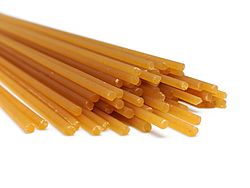Bigoli facts for kids
 |
|
| Type | Pasta |
|---|---|
| Place of origin | Italy |
| Region or state | Veneto |
| Main ingredients | Whole wheat flour |
| Variations | Pici |
Bigoli is a special type of pasta from Italy. It looks like a long, thick strand, similar to a very thick spaghetti. The name Bigoli is used in the Veneto region of Italy.
This pasta is usually made from whole wheat flour. Sometimes, it even includes duck eggs to give it a richer flavor.
Contents
What is Bigoli?
Bigoli is a type of pasta that is extruded. This means the dough is pushed through a special machine to create its long, thick shape. Think of it like squeezing toothpaste from a tube, but with pasta dough!
How is Bigoli Made?
The dough for Bigoli is pressed through a machine called a bigolaro. This machine has small holes that shape the pasta into its unique thick strands. The pasta gets its name from this special machine.
Where Does Bigoli Come From?
Bigoli is a traditional pasta from the Veneto region in northeastern Italy. A similar type of pasta, called pici, is made in Tuscany. While they are alike, Bigoli is known for its thicker, rougher texture, which helps sauces stick to it better.
The History of Bigoli
The exact beginning of Bigoli is a bit of a mystery, but everyone agrees it started in the Veneto region of Italy.
An Early Idea
One story says that Bigoli first appeared in the 14th century. During a time when Venice was at war, many ships carrying durum wheat were sunk. To make the remaining flour last, people mixed it with common wheat flour. This new dough was then shaped into thick spaghetti-like strands and called bigolo.
A Special Machine
A big moment for Bigoli happened in 1604. A pasta maker from Padua, named Bartolomio Veronese (also known as Abbondanza), created and patented a special press. This machine made it much easier to produce Bigoli, helping it become very popular.
Bigoli's First Mentions
Another idea about Bigoli's history suggests it developed from an older type of pasta already common in northeastern Italy. Bigoli was first officially mentioned in the 15th century. This happened at the court of the Bishop of Eraclea, showing it was already a recognized food.
See also
 In Spanish: Bigoli para niños
In Spanish: Bigoli para niños

